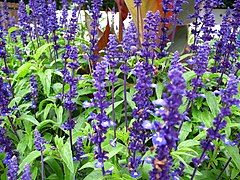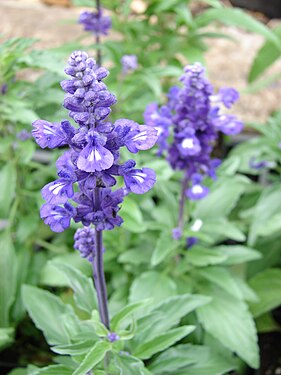Difference between revisions of "Salvia farinacea"
| Line 1: | Line 1: | ||
{{SPlantbox | {{SPlantbox | ||
|familia=Lamiaceae | |familia=Lamiaceae | ||
| − | |genus=Salvia | + | |genus=Salvia |
|species=farinacea | |species=farinacea | ||
| + | |taxo_author=Benth. | ||
|common_name=Mealy sage | |common_name=Mealy sage | ||
|name_ref=Flora - A Gardener's Encyclopedia | |name_ref=Flora - A Gardener's Encyclopedia | ||
| Line 22: | Line 23: | ||
|usda_ref=Flora - A Gardener's Encyclopedia | |usda_ref=Flora - A Gardener's Encyclopedia | ||
|max_zone=11 | |max_zone=11 | ||
| − | |image= | + | |image=1296 - Zell am See - Flowers.JPG |
|image_width=240 | |image_width=240 | ||
}} | }} | ||
| − | + | '''''Salvia farinacea''''' ('''Mealy sage''', '''Mealycup sage''') is a herbaceous perennial native to [[Mexico]] and parts of the United States including [[Texas]]. Violet-blue spikes rest on a compact plant of typically narrow salvia-like leaves, however, the shiny leaves are what set this species apart from a more most other ''Salvia'', which bear velvety-dull leaves. This plant requires full or part-sun and will grow to 18" or more with good soil. This plant will attract [[butterfly|butterflies]] and [[hummingbird|hummingbirds]]. | |
| − | + | ||
| − | |||
| − | |||
| − | |||
| − | |||
| − | |||
| − | |||
| − | |||
| − | |||
| − | |||
| − | |||
| − | |||
| − | |||
| − | |||
| − | |||
| − | |||
| − | |||
| − | |||
| − | |||
| − | |||
| − | | | ||
| − | | | ||
| − | |||
| − | |||
| − | |||
| − | |||
| − | |||
| − | |||
| − | |||
{{Inc| | {{Inc| | ||
| − | + | Salvia farinacea, Benth. Perennial, 2-3 ft. high: st. herbaceous, erect, tomentose: lvs. petiolate, ovate-oblong or lanceolate, rather obtuse, irregularly serrate-crenate, rather glabrous, both surfaces green or the lower canescent: floral lvs. small, deciduous: racemes elongated, simple; floral whorls many-fld., subsecund, remote or the uppermost approximate; calyx subsessile, tubular, purplish colored, densely white-lanate; corolla purple or violet, the tube scarcely exserted. Summer. Texas, where it is reported as growing in rich soil.—A showy frequently cultivated species, the fls. quite attractive, the darker corollas being set off by the mealy lighter violet-white calices. Var. alba, Hort., is a white-fld. form with the midlobe of the lower corolla-lip obcordate, 2-lobed. | |
| − | Salvia farinacea, Benth. Perennial, 2-3 ft. high: st. herbaceous, erect, tomentose: lvs. petiolate, ovate-oblong or lanceolate, rather obtuse, irregularly serrate-crenate, rather glabrous, both surfaces green or the lower canescent: floral lvs. small, deciduous: racemes elongated, simple; floral whorls many-fld., subsecund, remote or the uppermost approximate; calyx subsessile, tubular, purplish colored, densely white-lanate; corolla purple or violet, the tube scarcely exserted. Summer. Texas, where it is reported as growing in rich soil | ||
{{SCH}} | {{SCH}} | ||
}} | }} | ||
==Cultivation== | ==Cultivation== | ||
| − | + | ||
===Propagation=== | ===Propagation=== | ||
| − | + | ||
===Pests and diseases=== | ===Pests and diseases=== | ||
| − | |||
| − | == | + | |
| − | + | ==Varieties== | |
| + | |||
==Gallery== | ==Gallery== | ||
| − | |||
| − | <gallery> | + | <gallery perrow=5> |
| − | + | File:Starr 070906-8642 Salvia farinacea.jpg | |
| − | + | File:Kacolaz1.jpg | |
| − | + | File:Salvia farinacea 0.3 R.jpg | |
| + | File:Salvia farinacea4.jpg | ||
</gallery> | </gallery> | ||
==References== | ==References== | ||
| + | <references/> | ||
*[[Standard Cyclopedia of Horticulture]], by L. H. Bailey, MacMillan Co., 1963 | *[[Standard Cyclopedia of Horticulture]], by L. H. Bailey, MacMillan Co., 1963 | ||
<!--- xxxxx *Flora: The Gardener's Bible, by Sean Hogan. Global Book Publishing, 2003. ISBN 0881925381 --> | <!--- xxxxx *Flora: The Gardener's Bible, by Sean Hogan. Global Book Publishing, 2003. ISBN 0881925381 --> | ||
| Line 92: | Line 65: | ||
{{stub}} | {{stub}} | ||
| − | + | __NOTOC__ | |
| − | |||
| − | |||
Revision as of 21:02, 7 May 2010
| Height: | ⇕ | 36 in"in" can not be assigned to a declared number type with value 36. to 48 in"in" can not be assigned to a declared number type with value 48. |
|---|---|---|
| Width: | ⇔ | 24 in"in" can not be assigned to a declared number type with value 24. |
| Lifespan: | ⌛ | perennial |
| Exposure: | ☼ | sun |
|---|---|---|
| USDA Zones: | 9 to 11 | |
| Flower features: | ❀ | blue, purple, white |
|
Salvia > |
Benth. > |
Salvia farinacea (Mealy sage, Mealycup sage) is a herbaceous perennial native to Mexico and parts of the United States including Texas. Violet-blue spikes rest on a compact plant of typically narrow salvia-like leaves, however, the shiny leaves are what set this species apart from a more most other Salvia, which bear velvety-dull leaves. This plant requires full or part-sun and will grow to 18" or more with good soil. This plant will attract butterflies and hummingbirds.
Read about Salvia farinacea in the Standard Cyclopedia of Horticulture
|
|---|
|
Salvia farinacea, Benth. Perennial, 2-3 ft. high: st. herbaceous, erect, tomentose: lvs. petiolate, ovate-oblong or lanceolate, rather obtuse, irregularly serrate-crenate, rather glabrous, both surfaces green or the lower canescent: floral lvs. small, deciduous: racemes elongated, simple; floral whorls many-fld., subsecund, remote or the uppermost approximate; calyx subsessile, tubular, purplish colored, densely white-lanate; corolla purple or violet, the tube scarcely exserted. Summer. Texas, where it is reported as growing in rich soil.—A showy frequently cultivated species, the fls. quite attractive, the darker corollas being set off by the mealy lighter violet-white calices. Var. alba, Hort., is a white-fld. form with the midlobe of the lower corolla-lip obcordate, 2-lobed. CH
|
Cultivation
Propagation
Pests and diseases
Varieties
Gallery
References
- Standard Cyclopedia of Horticulture, by L. H. Bailey, MacMillan Co., 1963
External links
- w:Salvia farinacea. Some of the material on this page may be from Wikipedia, under the Creative Commons license.
- Salvia farinacea QR Code (Size 50, 100, 200, 500)




